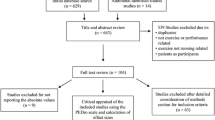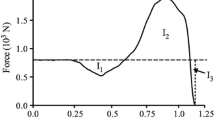Abstract
Purpose
This study aimed at investigating the effectiveness of compression stockings to prevent muscular damage and preserve muscular performance during a half-ironman triathlon.
Methods
Thirty-six experienced triathletes volunteered for this study. Participants were matched for age, anthropometric data and training status and placed into the experimental group (N = 19; using ankle-to-knee graduated compression stockings) or control group (N = 17; using regular socks). Participants competed in a half-ironman triathlon celebrated at 29 ± 3 °C and 73 ± 8 % of relative humidity. Race time was measured by means of chip timing. Pre- and post-race, maximal height and leg muscle power were measured during a countermovement jump. At the same time, blood myoglobin and creatine kinase concentrations were determined and the triathletes were asked for perceived exertion and muscle soreness using validated scales.
Results
Total race time was not different between groups (315 ± 45 for the control group and 310 ± 32 min for the experimental group; P = 0.46). After the race, jump height (−8.5 ± 3.0 versus −9.2 ± 5.3 %; P = 0.47) and leg muscle power reductions (−13 ± 10 versus −15 ± 10 %; P = 0.72) were similar between groups. Post-race myoglobin (718 ± 119 versus 591 ± 100 μg/mL; P = 0.42) and creatine kinase concentrations (604 ± 137 versus 525 ± 69 U/L; P = 0.60) were not different between groups. Perceived muscle soreness (5.3 ± 2.1 versus 6.0 ± 2.0 arbitrary units; P = 0.42) and the rating of perceived effort (17 ± 2 versus 17 ± 2 arbitrary units; P = 0.58) were not different between groups after the race.
Conclusion
Wearing compression stockings did not represent any advantage for maintaining muscle function or reducing blood markers of muscle damage during a triathlon event.

Similar content being viewed by others
Abbreviations
- CK:
-
Creatine kinase
- CMJ:
-
Countermovement vertical jump
- EDTA:
-
Ethylenediaminetetraacetic acid
- ES:
-
Effect size
- F2:
-
Second peak of ground reaction force during the landing
- LDH:
-
Lactate dehydrogenase
- SD:
-
Standard deviation
- VO2 :
-
Oxygen uptake
References
Agnelli G (2004) Prevention of venous thromboembolism in surgical patients. Circulation 110:IV4–IV12
Agu O, Baker D, Seifalian AM (2004) Effect of graduated compression stockings on limb oxygenation and venous function during exercise in patients with venous insufficiency. Vascular 12:69–76
Ali A, Caine MP, Snow BG (2007) Graduated compression stockings: physiological and perceptual responses during and after exercise. J Sports Sci 25:413–419
Ali A, Creasy RH, Edge JA (2010) Physiological effects of wearing graduated compression stockings during running. Eur J Appl Physiol 109:1017–1025
Bessa A, Nissenbaum M, Monteiro A, Gandra PG, Nunes LS, Bassini-Cameron A, Werneck-de-Castro JP, de Macedo DV, Cameron LC (2008) High-intensity ultraendurance promotes early release of muscle injury markers. Br J Sports Med 42:889–893
Born DP, Sperlich B, Holmberg HC (2013) Bringing light into the dark: effects of compression clothing on performance and recovery. Int J Sports Physiol Perform 8:4–18
Bringard A, Perrey S, Belluye N (2006) Aerobic energy cost and sensation responses during submaximal running exercise—positive effects of wearing compression tights. Int J Sports Med 27:373–378
Burden RJ, Glaister M (2012) The effects of ionized and nonionized compression garments on sprint and endurance cycling. J Strength Cond Res 26:2837–2843
Clarkson PM, Sayers SP (1999) Etiology of exercise-induced muscle damage. Can J Appl Physiol 24:234–248
Cohen J (1992) A power primer. Psychol Bull 112:155–159
Del Coso J, Gonzalez-Millan C, Salinero JJ, Abian-Vicen J, Soriano L, Garde S, Perez-Gonzalez B (2012a) Muscle damage and its relationship with muscle fatigue during a half-iron triathlon. PLoS ONE 7:e43280
Del Coso J, Salinero JJ, Abián-Vicen J, González-Millán C, Garde S, Vega P, Pérez-González B (2012b) Influence of body mass loss and myoglobinuria on development of muscle fatigue following a marathon in a warm environment. Appl Physiol Nutr Metab 38:286–291
Dascombe BJ, Hoare TK, Sear JA, Reaburn PR, Scanlan AT (2011) The effects of wearing undersized lower-body compression garments on endurance running performance. Int J Sports Physiol Perform 6:160–173
de Glanville KM, Hamlin MJ (2012) Positive effect of lower body compression garments on subsequent 40-kM cycling time trial performance. J Strength Cond Res 26:480–486
Doan BK, Kwon YH, Newton RU, Shim J, Popper EM, Rogers RA, Bolt LR, Robertson M, Kraemer WJ (2003) Evaluation of a lower-body compression garment. J Sports Sci 21:601–610
Duffield R, Portus M (2007) Comparison of three types of full-body compression garments on throwing and repeat-sprint performance in cricket players. Br J Sports Med 41:409–414
Duffield R, Edge J, Merrells R, Hawke E, Barnes M, Simcock D, Gill N (2008) The effects of compression garments on intermittent exercise performance and recovery on consecutive days. Int J Sports Physiol Perform 3:454–468
Duffield R, Cannon J, King M (2010) The effects of compression garments on recovery of muscle performance following high-intensity sprint and plyometric exercise. J Sci Med Sport 13:136–140
French DN, Thompson KG, Garland SW, Barnes CA, Portas MD, Hood PE, Wilkes G (2008) The effects of contrast bathing and compression therapy on muscular performance. Med Sci Sports Exerc 40:1297–1306
Hamdan A (2012) Management of varicose veins and venous insufficiency. JAMA 308:2612–2621
Higgins T, Naughton GA, Burgess D (2009) Effects of wearing compression garments on physiological and performance measures in a simulated game-specific circuit for netball. J Sci Med Sport 12:223–226
Hill J, Howatson G, van Someren K, Leeder J, Pedlar C (2013) Compression garments and recovery from exercise-induced muscle damage: a meta-analysis. Br J Sports Med. doi:10.1136/bjsports-2013-092456
Houghton LA, Dawson B, Maloney SK (2009) Effects of wearing compression garments on thermoregulation during simulated team sport activity in temperate environmental conditions. J Sci Med Sport 12:303–309
Houston M, Dolan S, Martin S (2011) The impact of physical, nutritional, and mental preparation on triathlon performance. J Sports Med Phys Fit 51:583–594
Ibegbuna V, Delis KT, Nicolaides AN, Aina O (2003) Effect of elastic compression stockings on venous hemodynamics during walking. J Vasc Surg 37:420–425
Jakeman JR, Byrne C, Eston RG (2010a) Efficacy of lower limb compression and combined treatment of manual massage and lower limb compression on symptoms of exercise-induced muscle damage in women. J Strength Cond Res 24:3157–3165
Jakeman JR, Byrne C, Eston RG (2010b) Lower limb compression garment improves recovery from exercise-induced muscle damage in young, active females. Eur J Appl Physiol 109:1137–1144
Jeukendrup AE, Jentjens RL, Moseley L (2005) Nutritional considerations in triathlon. Sports Med 35:163–181
Kemmler W, von Stengel S, Kockritz C, Mayhew J, Wassermann A, Zapf J (2009) Effect of compression stockings on running performance in men runners. J Strength Cond Res 23:101–105
Knechtle B, Knechtle P, Rosemann T, Oliver S (2010) A triple Iron triathlon leads to a decrease in total body mass but not to dehydration. Res Q Exerc Sport 81:319–327
Knechtle B, Knechtle P, Rosemann T (2011) Upper body skinfold thickness is related to race performance in male Ironman triathletes. Int J Sports Med 32:20–27
Kraemer W, Bush JA, Newton RU, Duncan DU, Volek JS, Denegar CR, Canavan P, Johnston J, Putukian M, Sebastianelli WJ (1998) Influence of a compression garment on repetitive power output production before and after different types of muscle fatigue. Sports Med Train Rehabil 8:163–184
Kraemer WJ, Volek JS, Bush JA, Gotshalk LA, Wagner PR, Gomez AL, Zatsiorsky VM, Duarte M, Ratamess NA, Mazzetti SA, Selle BJ (2000) Influence of compression hosiery on physiological responses to standing fatigue in women. Med Sci Sports Exerc 32:1849–1858
Kraemer WJ, Bush JA, Wickham RB, Denegar CR, Gomez AL, Gotshalk LA, Duncan ND, Volek JS, Putukian M, Sebastianelli WJ (2001) Influence of compression therapy on symptoms following soft tissue injury from maximal eccentric exercise. J Orthop Sports Phys Ther 31:282–290
Kraemer WJ, Flanagan SD, Comstock BA, Fragala MS, Earp JE, Dunn-Lewis C, Ho JY, Thomas GA, Solomon-Hill G, Penwell ZR, Powell MD, Wolf MR, Volek JS, Denegar CR, Maresh CM (2010) Effects of a whole body compression garment on markers of recovery after a heavy resistance workout in men and women. J Strength Cond Res 24:804–814
Lepers R, Sultana F, Bernard T, Hausswirth C, Brisswalter J (2010) Age-related changes in triathlon performances. Int J Sports Med 31:251–256
Lepers R, Knechtle B, Stapley PJ (2013) Trends in triathlon performance: effects of sex and age. Sports Med 43:851–863
MacRae BA, Cotter JD, Laing RM (2011) Compression garments and exercise: garment considerations, physiology and performance. Sports Med 41:815–843
MacRae BA, Laing RM, Niven BE, Cotter JD (2012) Pressure and coverage effects of sporting compression garments on cardiovascular function, thermoregulatory function, and exercise performance. Eur J Appl Physiol 112:1783–1795
Margaritis I, Tessier F, Verdera F, Bermon S, Marconnet P (1999) Muscle enzyme release does not predict muscle function impairment after triathlon. J Sports Med Phys Fit 39:133–139
Sawka MN, Burke LM, Eichner ER, Maughan RJ, Montain SJ, Stachenfeld NS (2007) American college of sports medicine position stand. Exercise and fluid replacement. Med Sci Sports Exerc 39:377–390
Schiff HB, MacSearraigh ET, Kallmeyer JC (1978) Myoglobinuria, rhabdomyolysis and marathon running. Q J Med 47:463–472
Sperlich B, Born DP, Haegele M, Zinner C, Holmberg HC (2011) Effects of compression textiles on performance enhancement and recovery. Sportverletzung Sportschaden: Organ der Gesellschaft fur Orthopadisch-Traumatologische Sportmedizin 25:227–234
Sperlich B, Born DP, Kaskinoro K, Kalliokoski KK, Laaksonen MS (2013) Squeezing the muscle: compression clothing and muscle metabolism during recovery from high intensity exercise. PLoS One 8:e60923
Tee JC, Bosch AN, Lambert MI (2007) Metabolic consequences of exercise-induced muscle damage. Sports Med 37:827–836
Vercruyssen F, Easthope C, Bernard T, Hausswirth C, Bieuzen F, Gruet M, Brisswalter J (2012) The influence of wearing compression stockings on performance indicators and physiological responses following a prolonged trail running exercise. Eur J Sport Sci 1–7. doi:10.1080/17461391.2012.730062
Acknowledgments
The authors wish to thank the subjects for their invaluable contribution to the study. In addition, they are very grateful to the Organization of Ecotrimad for their contribution to the study. This study did not receive any funding. Compression stockings for the experimental group were facilitated by Compressport España.
Conflict of interest
The authors declare that they have no conflict of interest derived from the outcomes of this study.
Author information
Authors and Affiliations
Corresponding author
Additional information
Communicated by Peter Krustrup.
Rights and permissions
About this article
Cite this article
Del Coso, J., Areces, F., Salinero, J.J. et al. Compression stockings do not improve muscular performance during a half-ironman triathlon race. Eur J Appl Physiol 114, 587–595 (2014). https://doi.org/10.1007/s00421-013-2789-2
Received:
Accepted:
Published:
Issue Date:
DOI: https://doi.org/10.1007/s00421-013-2789-2




